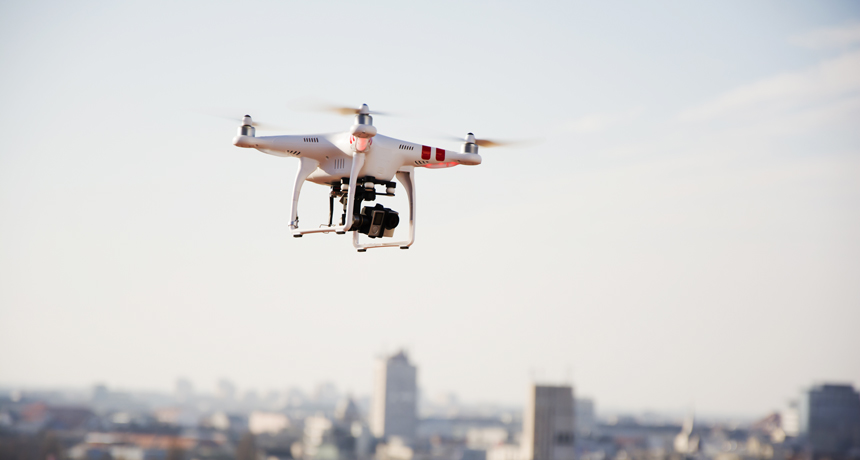
FLYING SPY A new method could reveal whether a suspicious, camera-equipped drone is snooping on you or your home.
newnow/Shutterstock
- More than 2 years ago
Now there’s a way to tell if a drone is spying on someone.
Researchers have devised a method to tell what a drone is recording — without having to decrypt the video data that the device streams to the pilot’s smartphone. This technique, described January 9 at arXiv.org, could help military bases detect unwanted surveillance and civilians protect their privacy as more commercial drones take to the skies.
“People have already worked on detecting [the presence of] drones, but no one had solved the problem of, ‘Is the drone actually recording something in my direction?’” says Ahmad Javaid, a cybersecurity researcher at the University of Toledo in Ohio, who was not involved in the work.
Ben Nassi, a software engineer at Ben-Gurion University of the Negev in Israel, and colleagues realized that changing the appearance of objects in a drone’s field of view influences the stream of encrypted data the drone sends to its smartphone controller. That’s because the more pixels that change from one video frame to the next, the more data bits the drone sends per second. So rapidly switching the appearance of a person or house and seeing whether those alterations correspond to higher drone-to-phone Wi-Fi traffic can reveal whether a drone is snooping.
Nassi’s team tested this idea by covering a house window with a smart film that could switch between transparent and nearly opaque, and aiming a drone with a video camera at the window from 40 meters away. Every two seconds, the researchers either flickered the smart film back and forth or left it transparent. They pointed a radio frequency scanner at the drone to intercept its outgoing Wi-Fi signals and found that its traffic spiked whenever the smart film flickered.
Story continues after graph
Window code
When smart film stretched across a window flips from transparent to nearly opaque (a “stimulus” interval), more pixels in a drone’s video change between frames. This increases the drone’s outgoing Wi-Fi traffic, compared with when the smart film stays transparent (“idle” intervals). The drone’s Wi-Fi signals rise above the cutoff rate — the halfway mark between the average stimulus and idle traffic levels — when researchers flickered the smart film.

For people without such radio equipment, it’s also possible to intercept Wi-Fi signals with a laptop or computer with a wireless card, says Simon Birnbach, a computer scientist at the University of Oxford not involved in the work.
In another test, a drone recorded someone wearing a strand of LED lights from about 20 meters’ distance. At five-second intervals, the person either flipped the LED lights on and off, or left them off. The drone camera’s data stream peaked whenever the LED lights flickered.
This strategy to discern a drone camera’s target is “a very cool idea,” says Thomas Ristenpart, a computer scientist at Cornell University not involved in the work. But the researchers need to test whether the method works in a wider range of settings and find ways to alter a drone’s view without cumbersome equipment, he says. “I don’t think anyone is going to want to wear a [light-up] shirt on the off chance a drone may fly by.”
Javaid agrees that this prototype system must be made more user-friendly to achieve widespread use. For home security, he imagines a small device stuck to a window that flashes a light and intercepts a drone’s Wi-Fi signals whenever it detects one nearby. The device could alert the homeowner if a drone is found scoping out the house.
Still, identifying a nosy drone may not always be enough to know who’s flying it. “It’s sort of the equivalent of knowing that an unmarked van pulled up and waited outside of your house,” says Drew Davidson, a computer scientist at Tala Security, Inc. in Dallas, who was not involved in the study. “Better to know than not, but not exactly enough for the police to find a suspect.”





